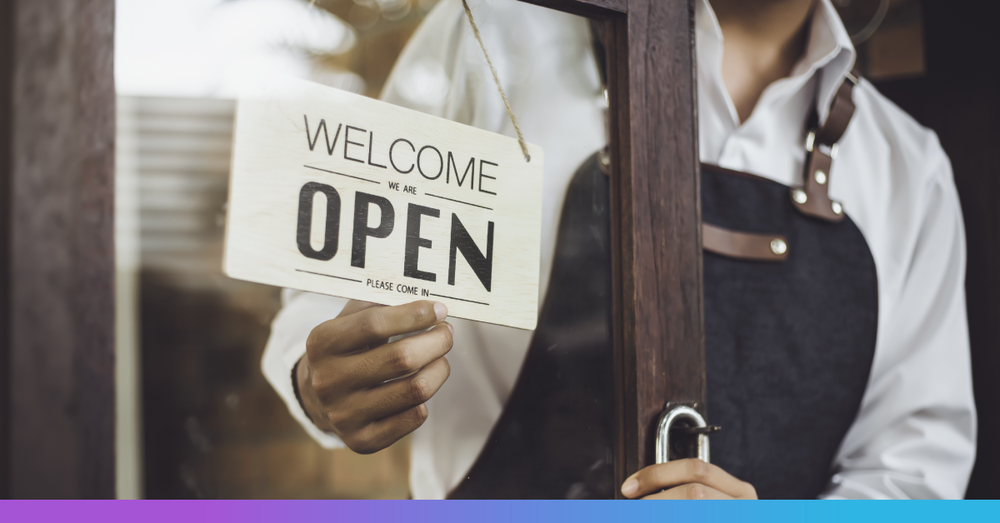
How to Kick Off Strong When the Pandemic is Over
Have you started planning for your store after lockdowns and ‘shelter at home’ orders are lifted?
While it’s true that much of the world is still on lockdown, there will come a time when stores will be allowed to open their doors once again. In-store sales will start picking up again as foot traffic increases, and the merchants who are adaptable and have plans in place for any changes to shopping patterns will be in a much better position to continue selling well beyond the pandemic lockdown.
That’s why it’s never too early to start planning. If you take proactive steps to market and improve your business during this period, you could hit the ground running when the coronavirus pandemic is over; even if that means that your store stays online, embraces omnichannel, or you have to adapt your business model.
Here are some suggestions on what you can do to prepare your store for emerging from lockdown.
Stay in constant contact with your customers
Whether or not you’re selling at the moment, it’s crucial that you keep in touch with your customers. Doing so helps you stay top of mind so that when shoppers are ready to make purchases, your store will automatically be on their radar.
The types of messages that you send will vary depending on the state of your business, but here are some ideas.
Online product launches
If you have new products in stock, find creative ways to launch (or re-launch) them digitally. Put out teasers, create email and social media campaigns, and try to generate as much excitement as possible.
Need an example? Check out this email from, T.C. Elli’s, which lets their customers know that they’re launching new products, and they’re doing so in an innovative and exciting way considering the circumstances around COVID-19 – They’re hosting a live video launch!
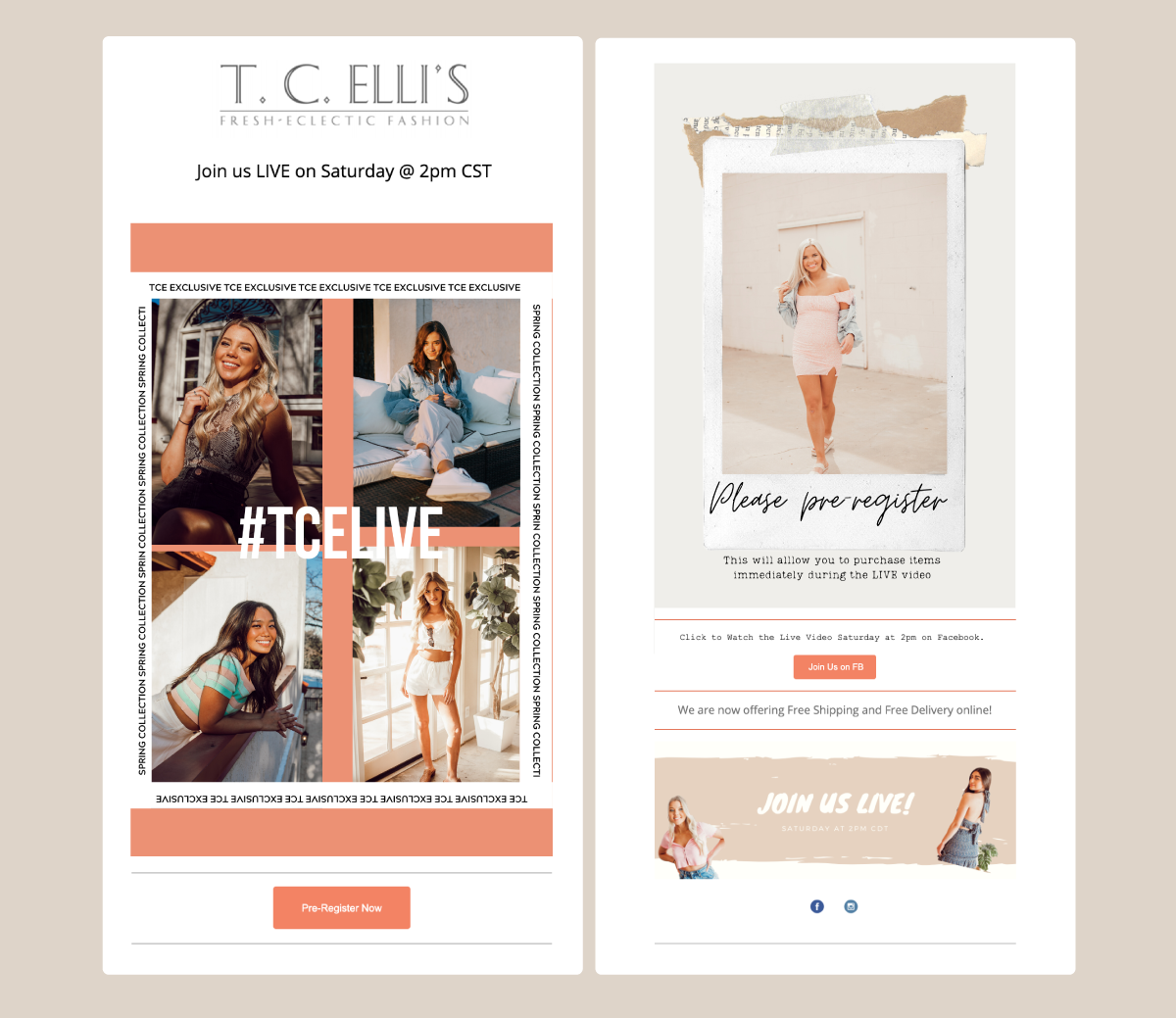
This clever email also allows T.C. Elli’s to capture customer information for a wide range of their customers, helping them to increase their marketing reach in the future.
Offers and promotions
If you’re still open or are currently selling online, continue emailing your subscribers about any sales or offers you have going on. You can make your offers more relevant by either running promotions on items that shoppers are likely to buy or by segmenting shoppers based on their brand interactions and activities.
Consider the case of Lightspeed & Shopify retailer, The BCode, a Havaianas and Skechers shoe distributor. Rather than sending out generic email blasts to everyone, The BCode makes use of customer segments. For instance, in the summer, they launched a campaign specifically for customers within their "loyal segment," and were able to convert 13.79% of subscribers – that’s way above the industry average.
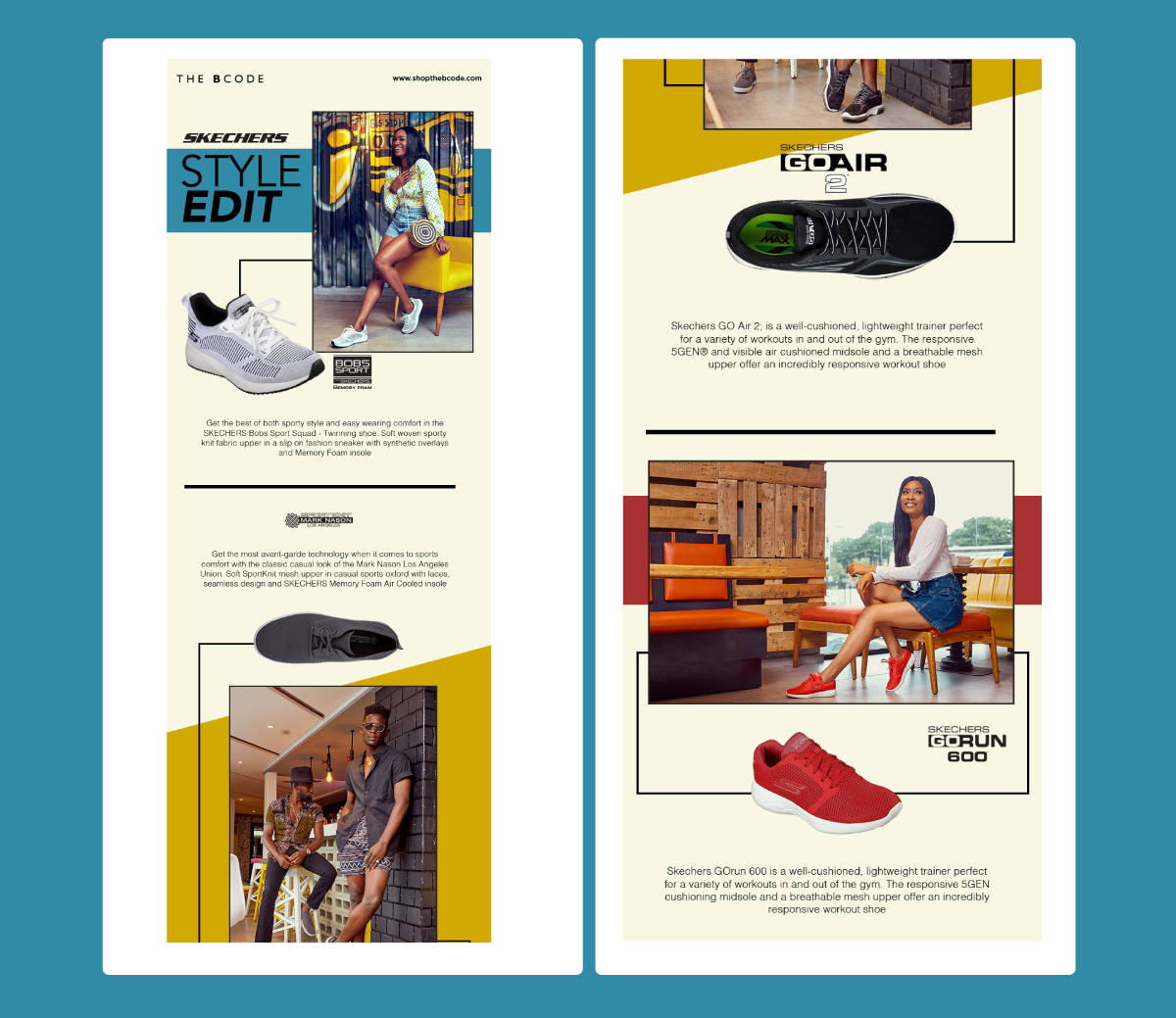
Company updates
People want to know what’s going on in your business, so keep shoppers posted on important updates to your company. Have you made any changes to your staff’s work arrangements? Do you have new policies in place? What can customers expect from you during these times?
Have a look at this email from Australian retailer, OnceWas.
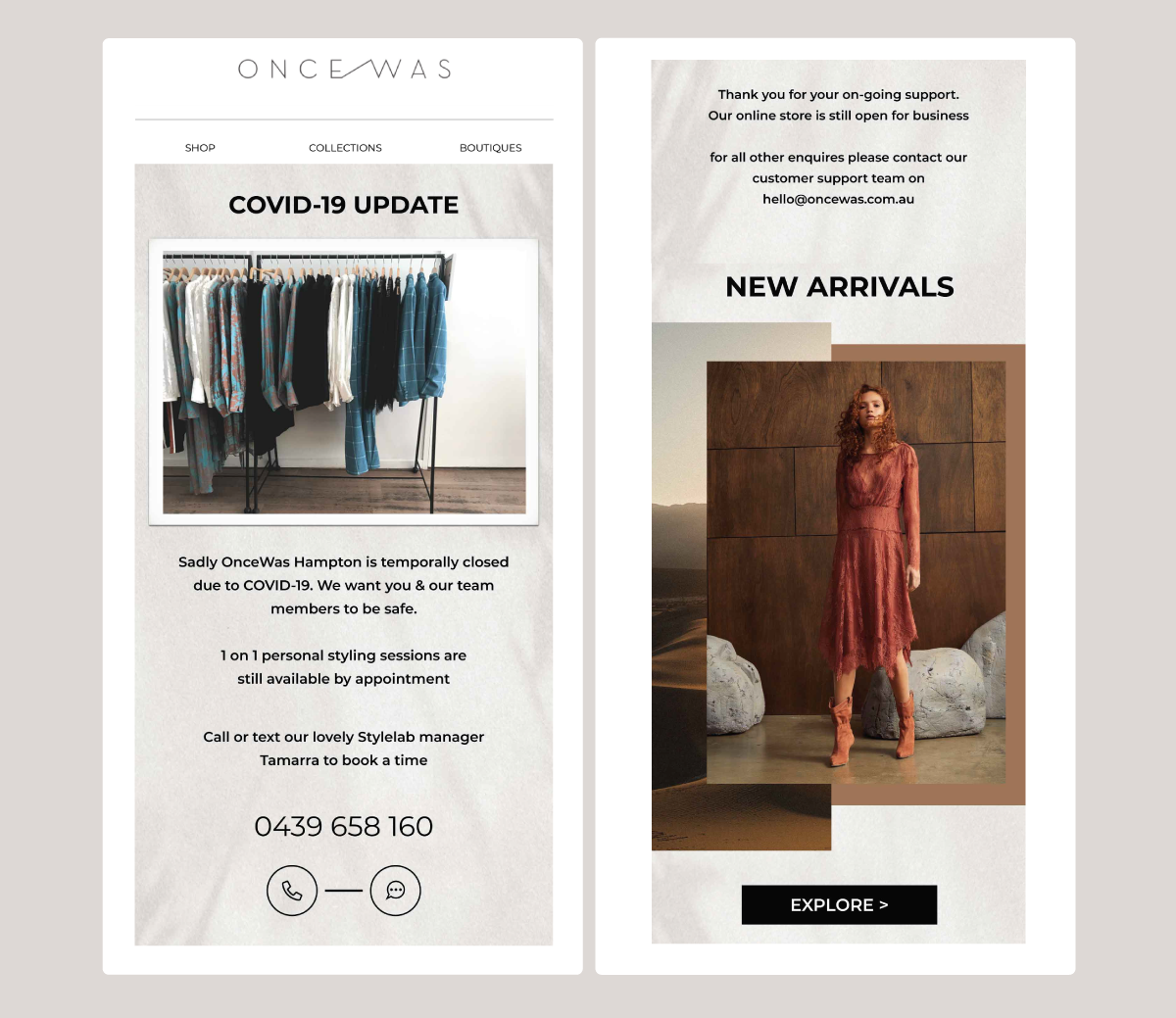
The OnceWas team uses a simple design to compliment a clear and concise message: that their Hampton-based brick-and-mortar store has temporarily closed as a direct result of COVID-19. But they don’t just leave the communication there, they go on to offer customers a styling service that encourages shoppers to stay engaged with OneWas and keep making purchases. OneWas further reinforces this objective by adding a link to new arrivals and encouraging their customers to ‘explore’.
OnceWas’ COVID-19 related update cleverly encourages customers to keep shopping, rather than dissuading them and that’s a powerful marketing strategy to have in their toolkit. Beautiful design and clear communication are a winning combination in getting customers to keep shopping with you, and OnceWas have mastered this!
Tighten up your existing systems
If you’re experiencing downtime due to the coronavirus, take this as an opportunity to tighten up all the operational tasks that you’ve been putting off.
Here are some ideas:
Count and reconcile your inventory
Keeping your stock in check can fall to the wayside especially during hectic shopping seasons. Doing a full inventory count takes several hours (sometimes a couple of days) and many stores can’t set aside that time when they’re busy selling.
So if you currently have some time on your hands, now is a good opportunity to really get a handle on your stock. Count your items so you can make sure that the inventory levels in your system match what you have in your physical store or warehouse.
Streamline manual tasks
Identify tasks that you’re still doing by hand, and find ways to automate them.
For instance, if you’re running a manual loyalty program that involves physical stamp cards, you could look into more modern solutions that allow you and your customers to track and redeem rewards easily.
Sales and inventory are two other common areas that small businesses should also look into. Many SMBs are still using pen and paper to track stock movements and revenues. If you’re one of them, it’s high time that you switch to a cloud-based POS and retail management system that automatically does that for you.
Streamlining manual tasks not only saves you a ton of time, it reduces human error and can also help grow your business. Switching to a modern loyalty solution, for instance, doesn’t just make it easier to run your rewards program, it also gives you the ability to offer better rewards and get to know your customers, which ultimately boosts shopper retention and revenues.
Integrate different platforms
Already using modern software in your business? Make sure they’re tightly integrated.
Let’s say you’re running an online shop and a brick-and-mortar store. In this case, you want to connect your POS system with your eCommerce platform, so that sales, inventory, and customer data flow easily between the two solutions.
You can even add in a loyalty integration, so you can run a rewards program seamlessly across online and offline channels. And now is the perfect time to start rewarding your customers who have shopped during retail restrictions, thereby encouraging those customers to keep coming back to your store long after you’ve come past lockdown.
One retailer that’s doing this well is Bulo Shoes, a retailer that runs a fully-integrated and robust retention strategy that runs across their online and brick-and-mortar stores.
“We linked Marsello to our online and physical stores with a loyalty program and automated email marketing, making it easy for us to communicate with customers regularly and to offer them rewards that keep them coming back," says Silas Gomez, eCommerce manager at Bulo Shoes.
“With the recent COVID-19 developments, we have been able to direct our customers to our online stores and keep them updated with any changes.”
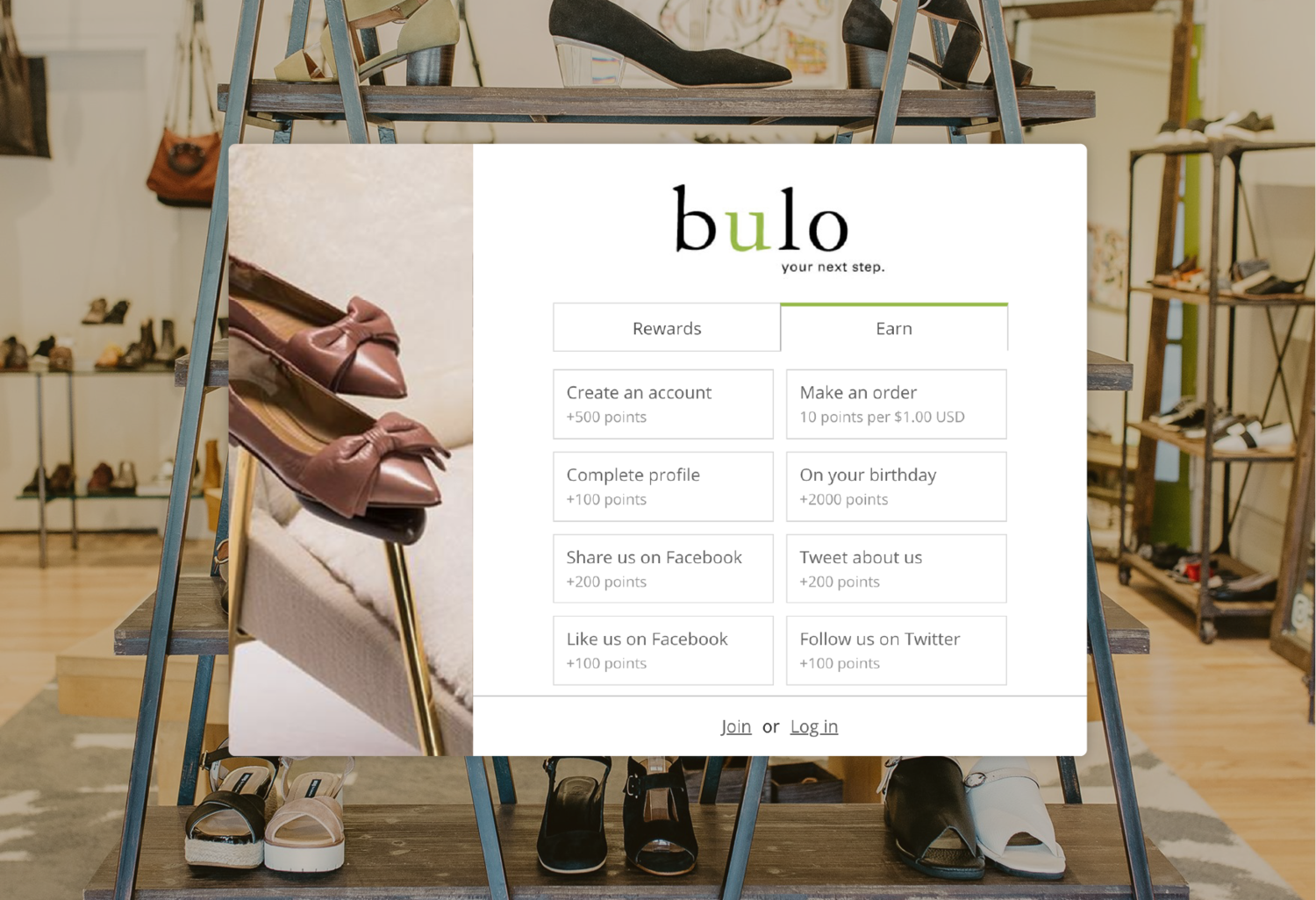
Bulo Shoes’ integrated strategy has paid off tremendously. The company is seeing 27x ROI by interlacing a generous loyalty program with a cleverly curated email marketing strategy.
Bulo Shoes also has a 13% repeat purchase rate across all their stores; they're seeing an engagement rate of 45% and they've generated over $7,800 in reward redemptions alone.
Keeping your physical and digital stores in sync means you never have to worry about double-selling products and you can provide a more seamless and rewarding shopping experience to your customers.
This is just one example of how you can integrate the apps in your business. Depending on the software you’re using, there are plenty of other solutions that you can connect, including:
-
Accounting software
-
Payment processor
-
Staff management
-
Reporting and analytics
The easiest way to connect your platforms is to use add-ons. For example, if you’re selling online, you can research the apps that your shopping cart integrates with.
That said, if you can’t find direct integrations, you can use a solutions like Zapier and IFTTT, which enables you to connect various apps together.
Check out our recent blogs on top apps for Shopify and BigCommerce & Lightspeed and save yourself the times spent researching.
Leverage data
It’s best to make data-backed decisions when planning for your re-opening, particularly when it comes to what products to market and sell.
Admittedly, COVID-19 makes this task a bit tricky. While historical data still has some value, it may not be as reliable, given the drastic changes that have occurred.
That said, there are a couple of things you can do that can help you determine your sales and marketing strategy going forward.
Engage in social listening
Pay attention to what your customers are saying online and on social media. What have they been up to? Have they developed new interests? Are there any products or services in particular that they’re looking into?
The answers to these questions can shed light on insights you can use when making stock, purchasing, and merchandising decisions for your re-opening.
Look into search trends
Use tools such as Google Trends and Keyword Planner to see what people are searching for online. What keywords (related to your vertical) are seeing more searches than usual?
Uncovering those search trends can take some digging, but you might discover useful nuggets along the way!
See what people are wishing for
If you have a wishlist feature on your website, you can use that to figure out what people want to buy. Dig into your wishlist data and use it to determine which products to market and sell.
When you combine the above with historical data and traditional demand forecasting, you’ll be able to effectively plan your assortment and sales initiatives.
Re-open with a splash
Re-opening your store is a big deal, so it’s fitting that you make your relaunch… well, big. Create a huge campaign around your grand re-opening.
Rather than just putting your “OPEN” sign back up and hoping people will come in, proactively implement strategies to drive traffic.
Here are a few ideas:
-
Launch celebratory offers and sales
-
Hold an in-store event complete with giveaways and swag bags
-
Email local press or influencers in your area to generate buzz
-
Market your grand reopening to email subscribers
-
Create a lead-up-to-opening campaign on your social media
-
Consider paid social media advertising to boost awareness
Implementing a combination of the above tactics will allow you to open with a splash. And when you combine these steps with the data-backed insights that we talked about above, you’ll be able to maximize traffic and sales.
Re-emphasize health and safety
Consumers will start shopping again, but they will likely be more cautious going back to brick-and-mortar stores.
Alleviate your customers’ concerns by communicating and enforcing extra health and safety measures. These measures will depend on your specific store, but will likely involve something along the lines of:
Encouraging space between shoppers
Maybe you need to keep your store displays and fixtures farther apart to give people more space to move around. You could also encourage physical space at the checkout counter by putting markers on the floor that are six feet apart, so shoppers know where they should stand while waiting in line.
Limiting physical contact
You could limit contact between customers and employees through things like self-checkout as well as by keeping your staff lean. You could also limit the number of people who can enter your store at any given time.
Added cleanliness and sanitation practices
Clean and sanitize your store often. Give extra attention to high-touch areas, such as popular product displays and the frequently visited sections of your store. If you have baskets or shopping carts, wipe them down before each shopper touches them.
And whatever measures you decide to take, communicate everything to your customers. Display prominent signage in-store and include your policies and action steps in all your customer communications.
For best results, use a reassuring tone in your messages. For instance, when emailing customers about your grand re-opening, craft a message that strikes a balance between promotional and reassuring. You want to welcome customers back to your business while making them feel safe and confident that they can shop at your store.
It’s never too early to prepare for retail’s bounce-back
While no-one knows for sure when retailers can open their doors again, it doesn’t hurt to be prepared. Laying the groundwork today will put you in a position to succeed tomorrow and beyond.
Let us know in the comments how you’re planning to re-open your store and excite your customers. Good luck and stay safe!


